Physical Address
304 North Cardinal St.
Dorchester Center, MA 02124
Disorders of the distal radioulnar joint (DRUJ) include those associated with pain or instability or both. In addition, one should consider pathology of degenerative or traumatic etiology. Injury to the triangular fibrocartilage complex can result in pain or instability or both, and may be traumatic or degenerative. Athletes, particularly those engaged in activities with repetitive axial loading, radial or ulnar deviation, and forearm rotation may especially be vulnerable, such as golfers, or those engaged in stick or racquet sports. Other pathology of DRUJ can include arthritis, which is beyond the scope of this chapter.
The triangular fibrocartilage complex (TFCC) is a ligamentous complex that has load-bearing and load-sharing functions, stabilizes the DRUJ, and acts as a suspensory structure for the ulnar carpus. In the setting of an injury, it can represent a source of pain and dysfunction.
Patients with TFCC pathology may present with ulnar-sided wrist pain with or without DRUJ instability. Other pathology that should be excluded in evaluation of the patient with a suspected TFCC injury include lunotriquetral ligament tears, pisiform pathology (instability, arthritis, fractures), triquetral fracture, hamate fracture, HALT (hamate arthritis lunotriquetral tear) syndrome, ECU pathology, DRUJ instability or arthritis, systemic arthritides, Kienböck disease, vasoocclusive disorders, compression of the ulnar nerve at Guyon canal, and others.
The DRUJ functions to allow rotation of the forearm. The ulna is the fixed unit of the forearm and the radius rotates around it at the sigmoid notch. Given that the radius of curvature of the sigmoid notch and the ulnar head differ, motion at this joint consists not only of rotation but also dorsal and volar translation. In addition, the lack of bony congruity also means that the DRUJ relies heavily on soft tissue constraints for stability. The TFCC consists of the central articular disk, dorsal and volar radioulnar ligaments, ulnolunate ligament, ulnotriquetral ligament, meniscal homologue, and the subsheath of the ECU tendon ( Fig. 72.1 ). These structures function as load sharing and load bearing, and also provide soft tissue stabilization. The radii of curvature of the sigmoid notch of the radius and the distal ulna are markedly different; thus the osseous structure of the DRUJ provides very little stability and stability relies heavily on soft tissue contributors, which include the dynamic stabilizers of the muscles, and the distal interosseous membrane, as well as the ligamentous structures of the TFCC complex.
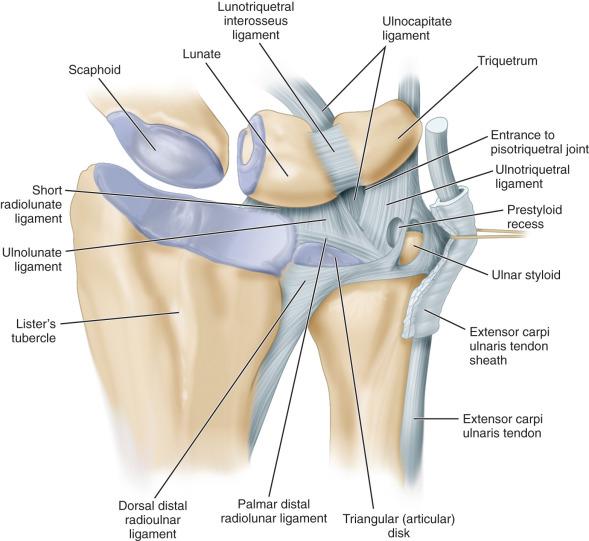
The main static soft tissue stabilizers of the DRUJ are the dorsal and volar radioulnar ligaments. These ligaments form the dorsal and volar margins of the TFCC and insert into the ulnar; the superficial fibers insert into the ulnar styloid tip whereas the deeper fibers, classically known as the ligamentum subcruentum, insert into the base or fovea of the distal ulna ( Fig. 72.2 ). The dorsal and volar radioulnar ligaments originate from the dorsal and volar ulnar corners of the distal radius. When viewed from distal to proximal, the arrangement of these ligaments with the sigmoid notch of the radius is triangular, hence the nomenclature of the TFCC. The deep and superficial fibers of the dorsal and volar radioulnar ligaments act differentially to provide stability, analogous to the reins of a “four in hand” team of horses. It is now known that the dorsal superficial and the palmar deep fibers of the ligamentum subcruentum tighten in pronation to stabilize the DRUJ, while the palmar superficial and the dorsal deep fibers are tight in supination, stabilizing the DRUJ.
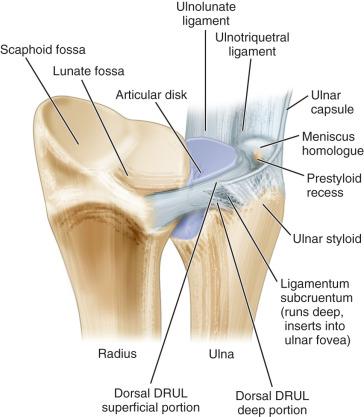
The central articular disk, which mainly consists of fibrocartilage, is bounded by the dorsal and volar radioulnar ligaments and the most ulnar aspect of the distal radius. It serves in load transmission from the ulnocarpal joint but does not itself confer considerable stability to the DRUJ. Consequently, many central disk tears may be simply débrided or left untreated without resulting clinical DRUJ instability.
The ulnolunate and ulnotriquetral ligaments are extrinsic structures that represent thickenings of the volar capsule. Although the name implies that the ligaments arise from the ulna and attach to the lunate and triquetrum, respectively, histologic studies have shown otherwise. These ligaments emanate from the volar portion of the volar radioulnar ligament and the central articular disk, not directly from the ulna. They add to the dorsal stability of the DRUJ and prevent excessive dorsal translation of the distal ulna relative to the carpus.
The meniscal homologue refers to a broad expansion of tissue traversing in a radioulnar direction from the central articular disk to the ulnar styloid and the surrounding joint capsule. It is composed of loose connective tissue and is itself not a major contributor to structural integrity of the TFCC. A nearby ulnar opening in the meniscal homologue is known as the prestyloid recess, which may be confused as a peripheral tear. It is not uncommon to see synovitis in the region of the prestyloid recess, which makes this distinction difficult at times.
The floor of the sixth dorsal extensor compartment is the ECU subsheath, which is continuous with the dorsal radioulnar ligament and meniscal homologue.
The blood supply to the TFCC originates from the terminal branches of the anterior and posterior interosseous arteries. Similar to the knee meniscus, the peripheral TFCC is well perfused via blood supply from the capsular attachments; however, the more central and radial aspects are poorly vascularized; thus only the peripheral 10% to 30% of the TFCC has a vascular supply, which results in the improved healing potential of peripheral compared to more central tears.
TFCC tears can result in ulnar-sided wrist pain as well as potentially DRUJ instability. TFCC tears are more common in those with ulnar positive or neutral variance than those with ulnar negative variance, who also have thicker articular disks.
The Palmar classification divides TFCC tears into traumatic versus degenerative (I vs. II) and secondarily into location (IA-D) versus progression (IIA-D) ( Table 72.1 ).
| Type | Description |
|---|---|
| I | Traumatic |
| IA | Central perforation of articular disk |
| IB | Foveal insertional tear, with or without ulnar styloid fracture |
| IC | Tear of ulnocarpal ligaments (ulnolunate and ulnotriquetral) |
| ID | Radial-sided insertional tear |
| II | Degenerative |
| IIA | Central wear of TFCC |
| IIB | Wear with chondromalacia of the lunate or ulnar head |
| IIC | TFCC perforation with chondromalacia |
| IID | TFCC perforation with chondromalacia and wear or tear of the LT ligament |
| IIE | TFCC perforation with chondromalacia and wear or tear of the LT ligament, with ulnocarpal arthritis |
The mechanism of injury with traumatic tears is believed to be an extension and pronation moment applied to an axially loaded wrist, although tears may also occur with hypersupination. Traumatic tears commonly occur in association with displaced distal radius fractures.
Class 1 tears are further subdivided based upon location (A, B, C, D). Class 1A represent a central perforation of the TFCC central articular disk and do not result in DRUJ instability. Class 1B tears represent an ulnar avulsion of the TFCC from the fovea and may be accompanied by an ulnar styloid fracture. Depending upon the extent of involvement of the distal radioulnar ligaments, patients may also have DRUJ instability. Class 1C tears involve the ulnolunate or ulnotriquetral ligaments, while the very rare 1D tear represents a radial-sided avulsion of the TFCC.
Class 2 tears represent the sequelae of ulnar impaction and are subdivided further by progression (A-E). Class 2A TFCC lesions represent wear or thinning of the TFCC, 2B lesions are those that demonstrate the findings seen in 2A plus ulnocarpal impaction with lunate or ulnar chondromalacia, 2C are those with the findings in 2B plus perforation of the TFCC, while 2D lesions demonstrate lunotriquetral ligament changes in addition to the findings of 2C. Lastly, 2E represents ulnocarpal arthritis.
Patients with TFCC injuries most commonly present with ulnar-sided wrist pain. However, the differential diagnosis of ulnar-sided wrist pain includes many different pathologies that must be excluded ( Table 72.2 ).
| Ulnar Impaction | Pisiform Pathology (Instability, Arthritis, Fractures) | ECU Instability | Vasoocclusive Disorders |
|---|---|---|---|
| TFCC tear | Triquetral fracture | DRUJ instability | DRUJ arthritis |
| Lunotriquetral tear | Hamate fracture | Ulnar tunnel syndrome | Systemic or crystalline arthropathy |
| Inflammatory arthritis | ECU tendinosis | HALT (hamate arthritis lunotriquetral tear) syndrome | Kienböck disease |
Patients may describe a history of a known acute injury or alternatively may relate a more insidious onset of ulnar-sided wrist discomfort. Although Class 2 tears are degenerative in nature, patients may have findings of ulnar impaction but may be asymptomatic or minimally symptomatic until after a traumatic episode that exacerbates their discomfort and brings symptoms to a level at which they complain. Pain is typically worsened with activities that involve pronosupination, twisting, gripping, or any element of ulnar deviation. Patients may describe instability or clicking or clunking with forearm rotation if DRUJ instability is a component. Specific inquiry into the location, onset of pain, relieving and exacerbating activities, and the results of any prior treatment is included in the history.
Patients with DRUJ instability often describe a single traumatic injury, although this may present insidiously over time. Patients often describe a clunk and pain with forearm rotation as the joint subluxates. They may note pain and worsening instability with axial loading (such as getting up from a chair) or complain of limited forearm rotation.
The physical examination begins with inspection of the skin for any lesions, trophic changes, scars, or deformities. Sensibility is assessed. Range of motion (ROM) in the flexion-extension, radial-ulnar deviation, and pronosupination planes is documented and compared to the contralateral side. Typically grip strength is measured on both sides and side-to-side comparisons are made, using a dynamometer at settings 1, 3, and 5. One can anticipate a normal bell-shaped curve over the three settings with appropriate effort, and typically the nondominant side (in a normal patient) will be 80% of the dominant side's strength. Grip strength is useful to evaluate success of treatment as well as to determine effort and compliance with the examination.
The wrist is palpated to determine areas of tenderness. In the setting of TFCC pathology, patients will usually have tenderness at the ulnar snuffbox (fovea). Alternatively or concomitantly with TFCC pathology, patients may have tenderness over the lunotriquetral (LT) interval, the extensor carpi ulnaris (ECU) tendon, and the DRUJ. It is important to distinguish between other causes of ulnar-sided wrist pain including hook of hamate fracture (tenderness over the hook of the hamate); pisotriquetral instability or arthritis (pisotriquetral grind testing) with or without secondary flexor carpi ulnaris (FCU) pathology (tenderness over the FCU tendon and pain over the FCU with resisted wrist flexion); ECU tendonitis (ECU synergy test ) or ECU subluxation (instability of the ECU particularly with pronosupination); DRUJ instability (piano key testing, subluxation or instability with pronosupination); or DRUJ arthritis (crepitus and pain with forearm rotation, pain with compression of the DRUJ). The TFCC stress test, performed by axially loading the wrist in ulnar deviation with pronosupination, may be positive (cause pain) in the setting of a TFCC tear, but is relatively nonspecific as it can also be painful in the setting of LT tears. Patients may be asked to “push up” from a chair (with the forearm pronated and axially loaded); pain can indicate TFCC pathology.
It is often quite helpful to consider diagnostic as well as potentially therapeutic differential injections with local anesthesia and/or corticosteroid to further clarify the site of pathology and to assess the patient's potential response to intervention at that site.
Typical plain radiographs obtained in the setting of ulnar-sided wrist pain include posteroanterior, lateral, and oblique films. If pisotriquetral arthritis or a hook of hamate fracture is suspected, semi-supinated oblique views and or a carpal tunnel view may be obtained. If a TFCC tear is suspected, PA grip views of the affected and unaffected (for comparison) wrists on separate cassettes may be taken to evaluate for dynamic ulnar variance. PA grip views on the same cassette may be rotated and make evaluation of ulnar variance difficult. In any case, the appropriate positioning of the patient to evaluate ulnar variance involves the shoulder abducted, the elbow flexed, and the forearm in neutral position ( Fig. 72.3 ). Lateral x-rays are specifically examined to assess congruity of the distal radioulnar joint.
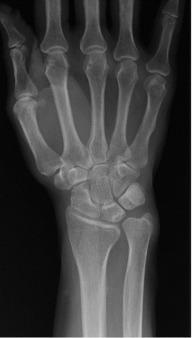
Computed tomography (CT) scans are particularly useful to evaluate for DRUJ congruity and changes in forearm rotation especially on the axial cuts obtained in pronation, supination, and neutral. In addition, in selected cases, it is often useful to image the contralateral wrist in similar positions of forearm rotation. When DRUJ instability occurs following, for example, after a distal radius fracture, it can be useful to examine the CT scan to determine if a malunited distal radius fracture or changes in the DRUJ are the primary cause of the instability as opposed to soft tissue problems such as a TFCC tear or disruption of the distal radioulnar ligaments. CT arthrography is mentioned for completeness, of mostly historical significance, and has largely been supplanted by magnetic resonance imaging (MRI) and MR arthrography. It is still occasionally used in patients who are unable to have a MRI.
Aside from inspection during arthroscopy, MRI is the most sensitive and specific imaging modality for evaluation of TFCC pathology ( Fig. 72.4 ). The preferred imaging is done with a dedicated wrist coil in a 3.0 T scanner or better, although satisfactory images may be obtained with a 1.5 T machine if needed. Anderson and colleagues demonstrated improved sensitivity of 94% with a 3.0 T scanner versus 85% sensitivity with a 1.5 T scanner. However, it is important to recall that although sensitivity and specificity to detect a tear is high, there is a high rate of communicating defects in the TFCC that have little clinical significance, and with increasing age, there is an increasing incidence of mostly asymptomatic TFCC pathology. As such, all imaging must be interpreted in the setting of clinical examination and history.
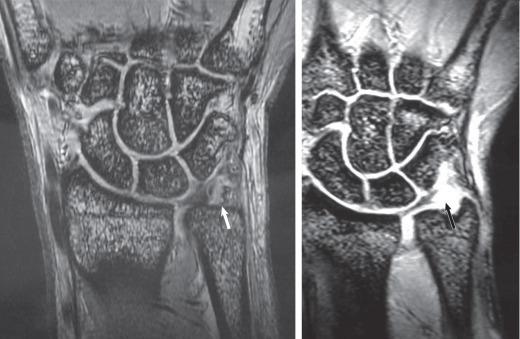
Use of MR arthrogram is a subject of controversy, with some centers noting that a high-resolution machine with a dedicated wrist coil is sufficient to detect most pathology without the risk of injection for arthrogram.
In the setting of acute DRUJ instability, nonoperative treatment may have a role. In cases of acute DRUJ dislocation, the DRUJ is reduced and the forearm splinted for 6 weeks in supination for dorsal dislocations or pronation for rare palmar dislocations. Chronic injury consisting of TFCC tears with DRUJ instability represent an indication for surgery, with either open or arthroscopic repair of TFCC to the fovea if the TFCC is reparable, or a DRUJ stabilization procedure if the TFCC is not reparable.
In the absence of DRUJ instability, the appropriate initial treatment of TFCC tears is nonoperative. In such cases, patients may benefit from reassurance about their condition, particularly in the setting of known or suspected TFCC pathology in association with distal radius fractures, in which TFCC pathology may resolve on its own within 6 to 12 months. Alternatively, patients may consider splinting for comfort, activity modification, and symptomatic care (nonsteroidal antiinflammatory drugs [NSAIDs], ice, therapy modalities), or injection of corticosteroid. Although immobilization is commonly used, there is no consensus regarding the benefits of full-time casting versus intermittent splinting, long arm versus short arm, or duration of splinting.
Patients who fail nonoperative treatment may be considered for surgery. Surgical options include open versus arthroscopic management. My preference is for open surgery for TFCC tears associated with DRUJ instability.
Arthroscopy begins with examination of the radiocarpal joint through the 3,4 and 6R portal. The TFCC is visualized and inspected and a probe placed on the TFCC to assess for any laxity with the “trampoline test.” I prefer to leave the tourniquet uninflated to better visualize any synovitis. Visualization from the 3,4 and 6R portal allows for assessment of the TFCC, as well as the lunotriquetral ligament and joint, in order to evaluate for ulnar impaction. Radial and ulnar midcarpal portals are placed to visualize in particular the lunotriquetral interval and the capitohamate interval, again, assessing for ulnar impaction or alternative pathologies. Once the diagnostic arthroscopy is completed, the TFCC and any synovitis can be débrided (Palmar 1A, 1D, and 2 lesions) or repaired (Palmar 1B), as described in Chapter 69 on wrist arthroscopy. Briefly, arthroscopic techniques for 1B tears involve either use of a suture anchor or passage of sutures via hollow-bore needles aimed from outside to in. Sutures are passed through the TFCC and repair is effectively to the capsule. In general, use of a 2-0 PDS suture is made and a small incision is made ulnarly to tie the sutures over the capsule and to avoid branches of the dorsal ulnar sensory nerve. Alternatively, a suture anchor may be placed into the fovea for a more anatomic repair. A high rate of good to excellent results may be anticipated with arthroscopic TFCC repair techniques.
In the setting of DRUJ instability, my preference is for open repair of the TFCC. In such cases, arthroscopy may be done as a diagnostic or confirmatory tool, but then an open incision is made ( Fig. 72.5 ). A longitudinal incision is made over the fifth extensor compartment that is opened and released. A horizontal capsulotomy is made parallel to the dorsal radioulnar ligament. I use a braided slowly absorbable suture or Prolene or PDS passed through the TFCC, then through holes drilled up into the foveal region and tied over the ulnar metaphyseal region. Use of Keith needles loaded on a mini-driver to pass through the bone facilitates passage of the sutures. An alternative is the use of a suture anchor either open or arthroscopically. In general, I do not repair 1D tears as the results following simple arthroscopic débridement are equally favorable with fewer complications.
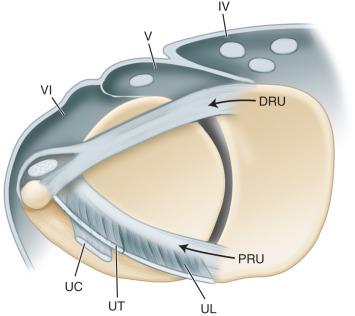
For Class 2 TFCC lesions, treatment options may include TFCC débridement alone or can include a joint leveling procedure, such as an arthroscopic or open-wafer procedure or an ulnar shortening osteotomy. Joint leveling procedures, such as an ulnar-shortening osteotomy, may result in more postoperative pain in the initial healing period, a requirement for cast or splint immobilization, and risk of failure to heal. If patients want definitive treatment in the setting of ulnar impaction, they may be offered TFCC débridement with joint leveling procedure at the same setting, accepting the increased risk and investment in time and recovery. Alternatively, if they wish to undergo the TFCC débridement alone they may be counseled that there is a higher risk of residual or recurrent discomfort, although it is possible these patients may respond to the lesser procedure.
Chronic DRUJ instability in the setting of an irreparable TFCC tear without DRUJ arthritis represents an indication for DRUJ stabilization and reconstruction procedure. There are a number of techniques that can be used including a distally based strip of the ECU tendon through the TFCC. More commonly, the use of a palmaris longus (PL) graft (or a strip of the flexor carpi ulnaris [FCU] if the PL is absent) is performed to reconstruct the distal radioulnar ligaments. A longitudinal incision is made over the fifth extensor compartment, the fifth compartment is opened, and the extensor digiti minimi (EDM) retracted. An “ L ”-shaped capsulotomy is made, with one limb proximal and parallel to the dorsal radioulnar ligament and the second limb along the sigmoid notch. The fovea is débrided of any scar tissue, retaining any functional remnants of the TFCC. The bone under the fourth extensor compartment is exposed along the dorsal margin of the sigmoid notch such that an area 5 mm proximal to the radiolunate joint and 5 mm radial to the sigmoid notch is revealed. This will be the site of a drill hole for passage of the tendon graft. A K wire is placed at this site from dorsal to volar and overdrilled with a 3.5-mm cannulated drill bit. A longitudinal volar-based incision just radial to the ulnar neurovascular bundle is made for exposure of the volar drill hole. The deep dissection goes between the digital flexors and the ulnar neurovascular bundle. A second tunnel site is identified from the fovea at the base of the ulnar styloid to the metaphyseal ulnar neck region. This may be created by flexing the wrist and placing a K wire from the fovea out ulnarly and proximally or alternatively from proximal ulnar to distal radially. A cannulated 3.5- to 4.0-mm drill bit is used to overdrill this site. Care is taken to avoid an iatrogenic fracture. The tendon graft is passed from volar to dorsal and retrieved ( Fig. 72.6 ). A hemostat is passed from dorsal to volar over the ulnar head and proximal to the remnants of the TFCC, exiting through the volar DRUJ capsule to grasp and retrieve the tendon graft, which is pulled into the dorsal wound. The two limbs of the tendon graft are then passed through the ulnar tunnel to exit at the ulnar border of the forearm. The two limbs are crossed then passed in opposite directions around the ulnar neck with the more dorsal one placed under the ECU, and after compression of the DRUJ and tensioning in neutral rotation, they are tied to each other, sutured in place, and cut. The DRUJ capsule is closed with nonabsorbable braided sutures and the EDM is left out of its retinacular sheath.
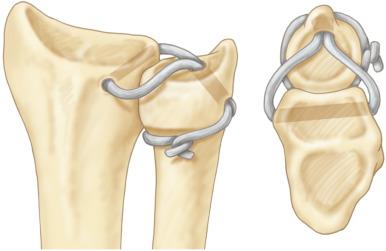
Following TFCC repair, most surgeons immobilize the patient for approximately 6 weeks, although there is no consensus regarding use of a long- versus short-arm cast of splint ( Fig. 72.7 ). I typically immobilize patients in a sugar-tong splint or a muenster cast for a total of 6 weeks following TFCC repair by any technique. Following this time period, the patient begins a progressive ROM and strengthening program with anticipated return to unrestricted and full activity by 3 months postop. Return to sport is generally allowed at this point, but may be dictated by return of motion and grip strength as well as the functional demands of the specific sport. For DRUJ reconstruction with a tendon graft, the patient is immobilized again for approximately 6 weeks, typically in a sugar-tong or muenster cast or splint for the first 3 to 4 weeks and either a muenster cast or a short arm cast for the remaining time.
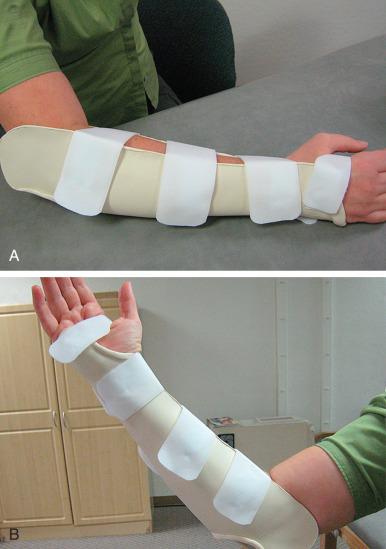
Complications of surgical treatment of TFCC tears or DRUJ instability include persistent wrist pain (particularly in the setting of TFCC débridement alone for ulnar impaction). In patients with known or suspected ulnar impaction who elect for TFCC débridement surgery, I counsel them prior to surgery and offer them one of two options: a TFCC débridement and if indicated, proceeding to simultaneous ulnar shortening osteotomy at the same surgical time versus simply proceeding with a TFCC débridement alone. TFCC débridement alone has a quicker recovery time and no risk of nonunion, but a heightened risk of recurrent or residual pain, but if it works for the patient, he or she may avoid the bigger procedure. Alternatively, if they elect for this option, patients should understand the risk of returning with residual or recurrent pain and desiring a future surgical procedure. Other risks associated with surgery include those inherent to surgery or wrist arthroscopy, as well as risk of dorsal ulnar sensory nerve neuritis, particularly with soft tissue or capsular repairs. Risks of DRUJ reconstruction include persistent or recurrent instability, worsening of any under-appreciated or unrecognized arthritis, and stiffness. If the tunnels are placed incorrectly, fracture of bony tunnels or entry into the joint can be problematic.
The author wishes to acknowledge the work of Drs. Corey A Pacek and Glenn Buterbaugh who were the authors of a chapter focused on injuries of the TFCC in the prior edition.
Become a Clinical Tree membership for Full access and enjoy Unlimited articles
If you are a member. Log in here